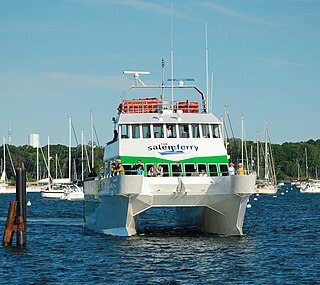
A multihull is a ship, vessel, craft or boat with more than one hull. Multihull ships include multiple types, sizes and applications. Hulls range from two to five, of uniform or diverse types and arrangements

A steamship, often referred to as a steamer, is a type of steam powered vessel, typically ocean-faring and seaworthy, that is propelled by one or more steam engines that typically move (turn) propellers or paddlewheels. The first steamships came into practical usage during the early 1800s; however, there were exceptions that came before. Steamships usually use the prefix designations of "PS" for paddle steamer or "SS" for screw steamer. As paddle steamers became less common, "SS" is assumed by many to stand for "steam ship". Ships powered by internal combustion engines use a prefix such as "MV" for motor vessel, so it is not correct to use "SS" for most modern vessels.

A catamaran is a multi-hulled watercraft featuring two parallel hulls of equal size. It is a geometry-stabilized craft, deriving its stability from its wide beam, rather than from a ballasted keel as with a monohull sailboat. Catamaran is from a Tamil word, kattumaran, which means "logs tied together".

A proa, also seen as prau, perahu, and prahu, or prow, is a type of multihull sailboat. It is a vessel consisting of two (usually) unequal length parallel hulls. It is sailed so that one hull is kept to windward, and the other to leeward, so that it needs to "shunt" to reverse direction when tacking. The English term proa usually refers specifically to the South Pacific proa as described in the journals of the British ship HMS Centurion.

A Small Waterplane Area Twin Hull, better known by the acronym SWATH, is a twin-hull ship design that minimizes hull cross section area at the sea's surface. Minimizing the ship's volume near the surface area of the sea, where wave energy is located, maximizes a vessel's stability, even in high seas and at high speeds. The bulk of the displacement necessary to keep the ship afloat is located beneath the waves, where it is less affected by wave action. Wave excitation drops exponentially as depth increases. Placing the majority of a ship's displacement under the waves is similar in concept to creating a ship that rides atop twin submarines.

Capsizing or keeling over occurs when a boat or ship is turned on its side or it is upside down in the water. The act of reversing a capsized vessel is called righting.

Incat Tasmania is a manufacturer of high-speed craft (HSC) catamaran ferries. Its greatest success has been with large, sea going passenger and vehicle ferries, but it has also built military transports and since 2015 it has built smaller river and bay ferries. Based in Derwent Park, a suburb of Hobart, Tasmania, Australia, it was founded by Bob Clifford.

Sea Shadow (IX-529) was an experimental stealth ship built by Lockheed for the United States Navy to determine how a low radar profile might be achieved and to test high stability hull configurations which have been used in oceanographic ships.

CCGS Frederick G. Creed is a hydrographic survey vessel operated by the Canadian Coast Guard on behalf of the Canadian Hydrographic Service, a scientific agency of the Department of Fisheries and Oceans. The ship was built in 1988 by Swath Ocean Systems Incorporated of San Diego, California and entered service the same year.

A bulbous bow is a protruding bulb at the bow of a ship just below the waterline. The bulb modifies the way the water flows around the hull, reducing drag and thus increasing speed, range, fuel efficiency, and stability. Large ships with bulbous bows generally have twelve to fifteen percent better fuel efficiency than similar vessels without them. A bulbous bow also increases the buoyancy of the forward part and hence reduces the pitching of the ship to a small degree.

Sir John Isaac Thornycroft (1843–1928) was an English shipbuilder, the founder of the Thornycroft shipbuilding company and member of the Thornycroft family.

Sea Fighter (FSF-1) is an experimental littoral combat ship under development (2005-2008) by the United States Navy. Its hull is of a small-waterplane-area twin-hull (SWATH) design, provides exceptional stability, even on rough seas. The ship can operate in both blue and littoral waters. For power, it can use either its dual gas-turbine engines for speed or its dual diesel engines for efficient cruising. It can be easily reconfigured through the use of interchangeable mission modules. Helicopters can land and launch on its deck. Smaller water craft can be carried and launched from its stern. The vessel is being developed under the program title Littoral Surface Craft-Experimental with a hull type designation Fast Sea Frame. The first vessel has been assigned the hull classification symbol FSF 1 and also has been referred to as the X-Craft. The vessel was designed by British company BMT Nigel Gee Ltd who continue with a role in the development of the vessel.

A pentamaran is a multihull vessel with five hulls, a further extension of the ideas behind trimarans and catamarans.
Wave-making resistance is a form of drag that affects surface watercraft, such as boats and ships, and reflects the energy required to push the water out of the way of the hull. This energy goes into creating the wave.
The Cangarda is a 126-foot (38 m) long luxury steam yacht built in 1901, at the Pusey and Jones Shipyard in Wilmington, Delaware.

LOMOcean Design is a naval architecture and yacht design company based in Auckland, New Zealand.
Juliet Marine Systems Ghost is an advanced super-cavitating stealth ship that can reduce hull friction to 1/900th that of conventional watercraft. It was developed to provide superior protection and capabilities for United States military personnel. It was designed, developed and built by private American company Juliet Marine Systems.

Chasina was an iron-hulled, steam-powered ship, originally built as a steam yacht, but later converted to a passenger-freighter vessel that served in coastal British Columbia and other areas during the early decades of the 1900s under the ownership several different companies. The ship disappeared in 1931 after leaving Hong Kong.

Abeking & Rasmussen (A&R) is a shipyard situated in Lemwerder, near Bremen in the German state of Lower Saxony. The shipyard is on the left bank of the River Weser, and currently comprises five production halls with associated workshops and offices, an inner harbour and a syncrolift.


















